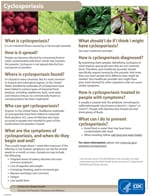Cyclosporiasis FAQs
On This Page
- What is Cyclospora?
- How is Cyclospora spread?
- Who is at risk for Cyclospora infection?
- What are the symptoms of Cyclospora infection?
- How long can the symptoms last?
- What should I do if I think I might be infected with Cyclospora?
- How is Cyclospora infection diagnosed?
- How is Cyclospora infection treated?
- I am allergic to sulfa drugs; is there another drug I can take?
- How is Cyclospora infection prevented?
What is Cyclospora?
Cyclospora cayetanensis is a parasite composed of one cell, too small to be seen without a microscope. This parasite causes an intestinal infection called cyclosporiasis.
How is Cyclospora spread?
Cyclospora is spread by people ingesting something—such as food or water—that was contaminated with feces (stool). Cyclospora needs time (typically, at least 1–2 weeks) after being passed in a bowel movement to become infectious for another person. Therefore, it is unlikely that Cyclospora is passed directly from one person to another.
Who is at risk for Cyclospora infection?
People living or traveling in tropical or subtropical regions of the world may be at increased risk for infection because cyclosporiasis is endemic (found) in some countries in these zones. In the United States, foodborne outbreaks of cyclosporiasis have been linked to various types of imported fresh produce. People can get infected with Cyclospora more than once.
What are the symptoms of Cyclospora infection?
The time between becoming infected and becoming sick is usually about 1 week. Cyclospora infects the small intestine (bowel) and usually causes watery diarrhea, with frequent, sometimes explosive, bowel movements. Other common symptoms include loss of appetite, weight loss, stomach cramps/pain, bloating, increased gas, nausea, and fatigue. Vomiting, body aches, headache, fever, and other flu-like symptoms may be noted. Some people who are infected with Cyclospora do not have any symptoms.
How long can the symptoms last?
If not treated, the illness may last from a few days to a month or longer. Symptoms may seem to go away and then return one or more times (relapse). It’s common to feel very tired.
What should I do if I think I might be infected with Cyclospora?
See your health care provider.
How is Cyclospora infection diagnosed?
Your health care provider will ask you to submit stool specimens to see if you are infected. You might be asked to submit more than one specimen from different days. Identification of this parasite in stool requires special laboratory tests that are not routinely done. Therefore, if indicated, your health care provider should specifically request testing for Cyclospora. In addition, your health care provider might have your stool checked for other organisms that can cause similar symptoms.
How is Cyclospora infection treated?
The recommended treatment is a combination of two antibiotics, trimethoprim-sulfamethoxazole, also known as Bactrim*, Septra*, or Cotrim*. People who have diarrhea should also rest and drink plenty of fluids.
I am allergic to sulfa drugs; is there another drug I can take?
No highly effective alternative drugs have been identified yet for people with Cyclospora infection who are unable to take sulfa drugs. See your health care provider to discuss potential options.
How is Cyclospora infection prevented?
Avoiding food or water that might have been contaminated with stool may help prevent Cyclospora infection.
Consumers and retailers should always follow safe fruit and vegetable handling recommendations:
Wash: Wash hands with soap and warm water before and after handling or preparing fruits and vegetables. Wash cutting boards, dishes, utensils, and counter tops with soap and hot water between the preparation of raw meat, poultry, and seafood products and the preparation of fruits and vegetables that will not be cooked.
Prepare: Wash all fruits and vegetables thoroughly under running water before eating, cutting, or cooking. Fruits and vegetables that are labeled “prewashed” do not need to be washed again at home. Scrub firm fruits and vegetables, such as melons and cucumbers, with a clean produce brush. Cut away any damaged or bruised areas on fruits and vegetables before preparing and eating.
Store: Refrigerate cut, peeled, or cooked fruits and vegetables as soon as possible, or within 2 hours. Store fruits and vegetables away from raw meat, poultry, and seafood.
* Use of trade names is for identification only and does not imply endorsement by the Public Health Service or by the U.S. Department of Health and Human Services.
This information is not meant to be used for self-diagnosis or as a substitute for consultation with a health care provider. If you have any questions about the parasites described above or think that you may have a parasitic infection, consult a health care provider.
